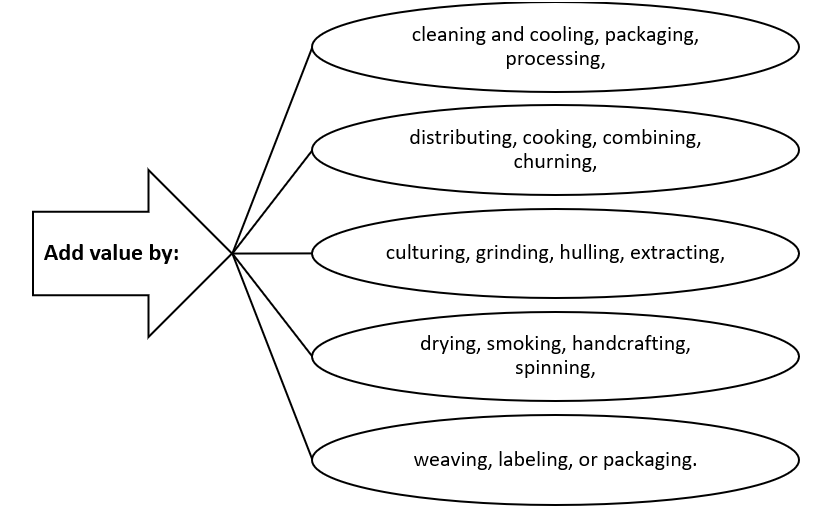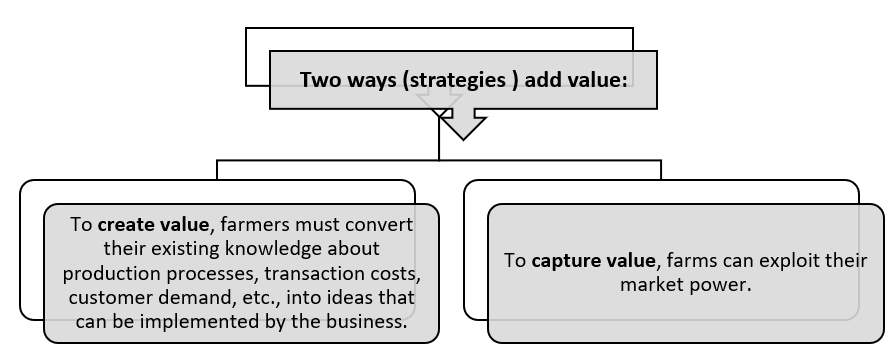Value-added agriculture is a process of increasing the economic value and consumer appeal of an agricultural commodity. It is an alternative production and marketing strategy that requires a better understanding of the rapidly changing food industry and food safety issues, consumer preferences, business savvy, and teamwork.
The more value you add to your raw product, the more appealing it will be to customers and the more they will pay for it. As farmers struggle to find ways to increase farm income, interest in “adding value” to raw agricultural products has grown tremendously. The value of farm products can be increased in endless ways:

Today, more than ever, adding value means “selling the sizzle, not the steak.” The “sizzle” comes from information, education, entertainment, image, and other intangible attributes. Because of the many regulations involved with food processing, some people may choose to add value in other ways. On a larger scale, producer-controlled processing for energy, fibre, and other non-food uses are options. On a smaller scale, items such as flower arrangements, garlic braids, grapevine wreaths, willow baskets, wheat straw weavings, sheep and goat milk soaps, and wool mulch are a few examples. In addition, ideas for providing entertainment, information, and other services associated with direct marketing are abundant.
Besides offering a higher return, value-added products can open new markets, create recognition for a farm, expand the market season, and make a positive contribution to the community. However, adding value is not a panacea for all the problems rural South Africa is facing. It is a long-term approach, not a “quick fix.” It requires the willingness and ability to take on risks, as well as adequate capital, management skills, and personal skills—such as the ability to interact with the public— to succeed.
There is a difference between a strategy to capture the value and a strategy to create value. This distinction is important to understand because each strategy offers specific opportunities and risks that influence the success or failure of the value-added venture.
For producers, capturing value usually means capturing some of the value-added by processing and marketing. More and more, producers are attempting to increase their share of income from food production by engaging in activities such as direct marketing to consumers, turning farm products into food products, and joining producer alliances and cooperatives that invest in facilities to process their farm products on a larger scale.
Producers do stand to benefit from diversifying into a value-added business related to the producer’s product when the product is characterised by volatile prices at the farm-gate level but relatively steady prices at the wholesale or retail level.

With a captured-value strategy, producers may face lower production risks, because production processes are well known and often linked to traditional agricultural production. Even when producers themselves are not familiar with processing, expertise in those areas can be hired. Captured-value ventures face an extremely competitive marketing environment, where demand is high, cost and efficiency considerations are paramount, and high volumes of products must be processed to gain efficiencies of scale. These ventures are often turning commodities into different commodities and, while value is added, it may not actually be captured by the producer.
A created-value strategy, on the other hand, relies on products or services that are unique or different from the mainstream equivalent. These often include a real or perceived quality attribute such as organic certification, a brand image, identification with a specific geographic region and/or producer, identity preservation, environmental stewardship, and so on. Creating value can pose higher production risks than capturing value. It usually requires learning new production and marketing skills, dealing with food safety, labelling, and other regulations, and coping with liability issues and insurance. Demand for the innovative product or service must usually be created through advertising, promotion, and consumer education, and this is a lengthy, expensive process. Marketing risks may be lower with a created-value strategy, for if this demand can be established, there is potential for higher, stable prices and little direct competition.
On-farm events and activities offer a unique setting that cannot be copied by other producers. However, producers will need to learn new marketing skills, carefully assess feasibility, and develop marketing plans for created-value products or services without established marketing channels.
The amount of value that can be added is affected by whether the enterprise is capturing or creating value. For example, product and market development and compliance with food safety and packaging laws all require time and money, which may be out of reach for the small producer. However, for the small-volume producer who cannot compete with the large-volume producers on price, targeting niche markets with a created-value strategy offers the highest likelihood of success.
Many producers combine aspects of both capturing and creating value in their ventures. A producer may create an unusual food product, such as local speciality bread, and sell it at the farmers’ market, capturing more of the food marketing Rand. Food processors may use organic or unusual ingredients, and so on.
Whichever way you choose to add value to your raw products your goal is to charge a higher price so as to increase your revenue. Some argue that if you don't have a percentage of people walking away from you at the market, you're selling too cheap. Setting a price is one of the more challenging tasks faced by all businesses, particularly the direct marketer. But how does one know how much a kilo of tomatoes, or ahead of lettuce is worth? On what information are these pricing decisions based?
Click here to view a video that explains how value can bed added to Agri products.
Click here to download a handout that explains the implications of the value chain and value add to products for the farmer.